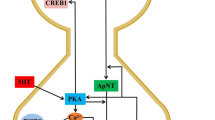Summary
We have examined the effects of temperature changes on the stretcher muscle and its motor supply in a crab (Pachygrapsus crassipes). An increase in temperature caused a decrease in the amplitude of evoked excitatory junctional potentials (ejp's). Above a critical threshold a single action potential in the excitor (E) or specific inhibitor (SI) axon provoked multiple spikes in the appropriate axon and concomitant ejp's or inhibitory junctional potentials (ijp's) in the stretcher muscle fibers. The critical temperature for generation of peripheral spikes was dependent upon the crab's thermal history.
In preparations in which a shock to the E axon evoked repetitive firing, stimulation of the SI axon at about the same time as the E axon abolished or curtailed the peripherally generated E axon responses. No reciprocal modulation of SI activity by the E axon was observed. GABA abolished the peripheral generation of E spikes and picrotoxin prevented SI modulation of E activity. We suggest that the site of SI modulation is at the axo-axonal synapses, possibly at the fine E axon branches and the ‘bottlenecks’ along the E axon where inhibitory synapses have been observed.
Similar content being viewed by others
Abbreviations
- CI :
-
common inhibitor (axon)
- E :
-
excitor (axon)
- ejp :
-
excitatory junctional potential
- ijp :
-
inhibitory junctional potential
- SI :
-
specific inhibitor axon
References
Atwood HL, Hoyle G, Smyth T (1965) Mechanical and electrical responses of single innervated crab-muscle fibers. J Physiol (Lond) 180:449–482
Colton CK, Freeman AR (1975) Dual response of lobster muscle fibers to L-glutamate. Comp Biochem Physiol 51C:275–284
Cossins AR, Friedlander MJ, Prosser CL (1977) Correlation between behavioural temperature adaptations of goldfish and the viscosity and fatty acid composition of their synaptic membranes. J Comp Physiol 120:109–121
Driedzig WM, Selivonchick DP, Roots BI (1976) Alk-I-enyl ethercontaining lipids of goldfish (Carassius auratus L.) brain and temperature acclimation. Comp Biochem Physiol 53B:311–314
Fatt P, Katz B (1953) The electrical response of crustacean muscle fibres. J Physiol (Lond) 120:171–204
Florey E, Hoyle G (1961) Neuromuscular synaptic activity in the crab (Cancer magister). In: Florey E (ed) Nervous inhibition. Pergamon, Oxford London New York Paris, pp 105–110
Florey E, Hoyle G (1976) The effects of temperature on a nervemuscle system of the Hawaiian ghost crabOcypode ceratophthalma (Pallas). J Comp Physiol 110:51–64
Hamby RJ (1975) Heat effects on a marine snail. Biol Bull 149: 331–347
Hammel HT, Stromme SB, Myrhe K (1969) Forebrain temperature activates behavioral thermoregulatory response in Arctic sculpins. Science 165:83–85
Harri M, Florey E (1977) The effects of temperature on a neuromuscular system of the crayfishAstacus leptodactylus. J Comp Physiol 177:47–61
Harri M, Florey E (1979) The effects of acclimation temperature on a neuromuscular system of the crayfishAstacus leptodactylus. J Exp Biol 78:281–293
Jahromi SS, Atwood HL (1974) Three dimensional ultrastructure of the crayfish neuromuscular apparatus. J Cell Biol 63: 599–613
Kerkut GA, Taylor BJR (1958) The effect of temperature changes on the activity of poikilotherms. Behaviour 13:259–279
Otsuka M, Iverson LL, Hall ZW, Kravitz EA (1966) Release of gamma-aminobutyric acid from inhibitory nerves of lobster. Proc Natl Acad Sci USA 56:1110–1115
Prosser CL (1973) Comparative animal physiology, 3rd ed. Saunders, Philadelphia, pp 966
Roots BI, Johnston PV (1968) Plasmalogens of the nervous tissue and environmental temperature. Comp Biochem Physiol 26:553–560
Takeuchi A, Takeuchi N (1969) A study of the action of picrotoxin on the inhibitory neuromuscular junction of the crayfish. J Physiol (Lond) 205:377–391
Wiens TJ, Atwood HL (1975) Dual inhibitory control in crab muscles. J Comp Physiol 99:211–230
Wiersma CAG, Ripley SH (1952) Innervation patterns of crustacean limbs. Comp Oecol 2:391–405
Author information
Authors and Affiliations
Additional information
This work was supported by grants awarded to Dr. Atwood from the National Research Council of Canada and the Muscular Dystrophy Association of Canada.
Rights and permissions
About this article
Cite this article
Stephens, P.J., Atwood, H.L. Peripheral generation and modulation of crustacean motor axon activity at high temperatures. J. Comp. Physiol. 142, 309–314 (1981). https://doi.org/10.1007/BF00605444
Accepted:
Issue Date:
DOI: https://doi.org/10.1007/BF00605444




